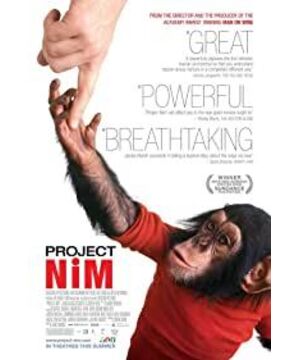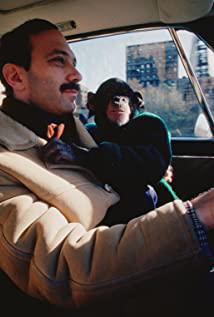Humans are probably the loneliest species on earth. The sudden emergence of a super high IQ, there is no rival on the earth. However, many people ignore a close relative of humans. How close is it? They will be nearly 99% similar to human DNA.
In "Rise of the Planet of the Apes", Caesar, a highly intelligent chimpanzee raised by humans, led the oppressed orangutans to rebel against humans, and eventually became the leader of the ape tribe... In reality, some scientists have really tried "Humanize" chimpanzees. Raise baby chimpanzees like human babies, breastfeed them, and teach them to communicate in sign language. Will it become a "person"? Will this experiment be successful?
The documentary "Project Nim" tells about such a bold and real experiment. The chimpanzee involved in this experiment is named Nim . Coincidentally, the release of "Project Nim" happened just one day before the release of "Rise of the Planet of the Apes".
Nim was born at the Primate Center in Oklahoma, USA in November 1973. Its biological mother is a chimpanzee named Caroline. Newborn Nim is adorable, looking like a human baby with hair. Snuggling in her mother's arms, it still doesn't know its own destiny, and it is about to undergo earth-shaking changes.
Chimpanzees are 99% genetically similar to humans, but they have not achieved the civilizational achievements of humans on Earth. With such close genes, one can't help but think that chimpanzees may have the potential to be "humanized". Professor Herbert Trace of Columbia University in New York decided to launch an experiment to train chimpanzees to express their thoughts , which he believes are like early evolutionary humans. The experiment could also help humans understand the evolution of language.
As a result, Nim, who was born a few days ago, was forcibly taken away from his mother and handed over to a human adoptive mother, Stephanie Lafarge . Stephanie, a former student of Herbert, a mother of several children, lived a prosperous life in Manhattan with her writer husband.
She has experience as a mother and has professional knowledge. In Herbert's view, Stephanie is the best mother candidate for chimpanzees.
Stephanie really treats Nim as her own, not only feeding Nim with the children, but also feeding Nim with her own milk. Dress Nim up to look more like a human baby.
A key part of this experiment was teaching Nim to communicate with people. Chimpanzees can't make sounds in human language, so Herbert wanted to teach Nimes sign language.
Nim is a fast learner, and it quickly understands sign language: me, eating, drinking, hugging, etc.
For example, putting your thumb to your mouth means drinking. If Nim makes this gesture, give him a drink.
But unlike human toddlers, Nim has a wild side to animals. In chimpanzees growing up, it was an instinct to challenge the males in the group. Stephanie's husband, Will, naturally became Nim's number one enemy in the family.
Nim would bite Will's arm hard and take Will's books off the shelf and throw them all over the place.
Herbert was not immune to Nim's tricks and attacks. But Herbert was not upset about it, because Herbert never thought of Nim as a child. Nim is just "a central link in a smart, behavioral research program."
The Stefani family's hippy rambling style, and the laissez-faire indulgence of Nimes, sign language education has also been slow to progress. She seemed to have forgotten that this was a scientific experiment, and was completely immersed in the idyllic life accompanied by the little orangutan. Herbert believes that if Nim continues to stay at Stephanie's house, the experiment will not work. He took Nim back to his laboratory and found a second adoptive mother for Nim: Laura Ann Padito .
Back in the closed, quiet environment of the laboratory, Nim's sign language has indeed improved a lot, and he has mastered many expressions in everyday language. More and more young people are joining the experiment as teachers in Nimes. In addition to teaching Nimes sign language, it will also teach it some daily habits such as dressing and undressing.
Nim uses sign language to express his needs , and most surprisingly, his fondness for cats. Nim often sign language to express that he wants to hug the cat, and the expression of Nim holding the cat is like being in heaven. The experiment quickly entered the public eye and was covered with great media fanfare. Nim became the most famous chimpanzee for a while, not only on the front pages of newspapers and magazines, but also on TV shows. Herbert also received a lot of financial support from the society.
In this way, the days of the stars holding the moon go by day by day, and Nim is also growing day by day. It gradually became a robust adult chimpanzee, no longer a docile and loving little orangutan.
As an adult chimpanzee, Nim has strong muscles, sharp canine teeth, and powerful jaws. Its wildness is gradually revealed, and when angry, it is more fierce than when it was a child.
Laura started thinking about quitting the experiment. As she packs her bags to leave, Nim seems to know she's going to be "abandoned." It pounced on Laura angrily, and it took four men to pull it away.
This made Laura more determined to leave. She believes that Nim's animal nature is destined to be impossible for him to understand human nature.
Finally one day in class, there is a serious biting incident - Nim bites the teacher Renee. The sharp canine teeth almost bit through Renee's face, and Renee also withdrew from the project.
Herbert himself admitted that he never got alone with Nim. Herbert didn't have much affection for Nim, who was just an experimental subject to him. "No one can keep chimpanzees for more than five years, because after five years they don't know how to control their power and they do a lot of harm to people," he said .
Ultimately, Herbert decided to stop the experiment altogether. On the one hand, as Nim grows up, he becomes more and more dangerous. On the other hand, the data accumulated in the past few years is already rich enough, it is time to stop and sort it out. In September 1977, Nim was sedated and sent back to the institute where he was born, where he was caged like the other chimpanzees used in the experiment.
None of the young people who participated in the experiment stood up to prevent Nim from becoming a prisoner. They're just kidding themselves: Nim will get used to it, it'll be fine.
Nim is not good. The orangutans in the institute are all tied to their necks by chains with locks. This is completely prison standards, and there are grid reinforcements on the periphery. Because there have been orangutan suicides before.
Herbert brought in a little orangutan to accompany Nim. Herbert did it more like a formality: Nim has friends, and I can leave it now.
After that, Nim was coaxed and coaxed into the iron cage. The people chained Nim into a cage, left a teddy bear and left. Nim shouted to come out, but the person who took care of it just walked away.
After that, Nim curled up all day long, losing interest in food. Raised as a human being, it cannot adapt to this prisoner's life.
One day, Herbert suddenly came to visit Nimes. Nim, who was very happy to see Herbert, rushed up and hugged Herbert tightly. Nim thought Herbert had come to pick it up. However, Herbert just returned to take a few interview photos with Nim and left. Never came back since.
The next morning, Nim barely ate anything. It realized that no one would come to its rescue.
However, when fate closes a door, it always opens a window. Someone who really cares about Nim and wants to befriend it shows up. The man, Bob Ingersoll , was one of Nim's breeders.
He was indignant about what happened to Nim. Bob tries to be friends with Nim and they quickly fall in love with each other. Although Nim is an orangutan, he can feel Bob's sincerity. Although animals are not as intelligent as humans, they are emotionally connected.
You have to be sincere when dealing with Nim, if you have a bad heart, he will know and don't like you anymore. On the other hand, Herbert made a name for himself with the Nim experiment, giving interviews everywhere. People were wondering if the experiment was successful and whether Nim had learned to express his thoughts in sign language. Herbert said contemptuously: "A series of gestures is not necessarily a complete sentence. You can learn many words by rote, but that does not mean that you can make sentences with grammar." In short, he believes that the experiment failed.
Bob said he didn't care if Nim could express complete sentences. This does not affect the communication between them. But the good times did not last long, and Nim was sold to the medical laboratory by the research center. The lab mainly uses orangutans to test human vaccines, and the government stipulates that new vaccines must be tested on four chimpanzees before they are put on the market. Imprisoned in a small iron cage, tortured by injections and the side effects of vaccines. This will be the rest of Nim's life.
At this point, the only person in the world who really cares about Nim is Bob Ingersoll. In order to rescue Nim, Bob runs around, appealing to the media, begging the lab.
And Herbert, who watched Nimes grow up, said grimly that he couldn't do anything.
With Bob's persistent efforts, the lab was pressured to release Nim. Afterwards, Nim was bought by a farm specializing in the rescue of abused animals, where he would spend the rest of his life.
But Nim is the only chimpanzee here, and it's lonely. Whenever it gets a chance, it sneaks out and stays in the human room.
Although Bob is eager to visit Nim, the farmer does not welcome Bob's interference. He threatened to call the police if Bob came.
Stephanie, the first adoptive mother, had visited Nim. When Nim saw the "mother" who abandoned it, all he showed was anger. It attacked Stephanie fiercely, but at the last moment it was merciful and did not kill her.
After that, Nim lived alone for ten years until the farm changed owners. Bob finally gets permission from the new farmer to meet Nim. Despite being apart for ten years, Nim recognized Bob right away. Bob choked and comforted Nim: Brother, things will get better...
Bob manages to rescue more chimpanzees from the lab and let two of them, Lulu and Mickey, live with Nim. Nim's mental condition gradually improved. After that, Nim and his mates spent five years here, during which time Bob came to visit frequently. In May 2000, Nim died of a heart attack at the age of 26.
Thanks to Bob's unremitting efforts, Nim's last days were quite successful. But all those who participated in Nim's plan undoubtedly caused great harm to Nim. Let it be separated from its original living environment and develop its human characteristics, but ignore its nature as a chimpanzee, and use it up and throw it away.
Perhaps the newborn Nim should not have been separated from its mother in the first place. Let it be an ordinary chimpanzee, at least it won't suffer so many abandonment and injuries later on. The complexity of human nature is even more stark in this experiment. Whether it's Herbert's ruthless selfishness or Bob's kind-hearted persistence, they belong to human beings. The highest animal on this earth.
*The author of this article: RAMA
View more about Project Nim reviews










